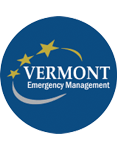The Vermont State Hazard Mitigation Planning Process brings together people interested in strengthening our environment, our buildings and our communities in the face of coming hazards. From ice storms to heat events, microbursts to flash flooding, climate change is increasing our risk, but we can increase our safety and resilience through intentional planning and preparation.
Stakeholders met throughout April 2023 to help develop a strategy to mitigate the impacts of natural hazards on Vermont’s communities and adapt to climate change. See details on engagement below.
The draft 2023 State Hazard Mitigation Plan (SHMP) update was available for public review and comment until Friday, August 25th. Please find the links to the draft documents and feedback form below.
You can still contact Stephanie Smith, State Hazard Mitigation Officer, and Caroline Paske, State Hazard Mitigation Planner (stephanie.a.smith@vermont.gov; caroline.paske@vermont.gov) with questions. Look for updates on plan implementation later this year.
Feedback Form: The feedback form for the 2023 State Hazard Mitigation Plan was available for those short on time or otherwise could not join us for a workshop. The form remained open until the end of May 2023 and has been reopened for comment on the draft 2023 SHMP until September 15th.
A virtual workshop orientation was offered live on Monday, March 27. The orientation can be beneficial whether you have been previously involved in state hazard mitigation planning or not. The orientation is geared towards those who want answers to questions such as “what is hazard mitigation,” “where is Vermont in the planning process right now,” or “why are we doing this?” A recording is available here.
In-person Workshop: The Hazard Mitigation Action Workshop was held in-person on Friday, April 7 from 9am to 4pm. We worked on developing the hazard mitigation and climate adaptation strategy for the 2023 State Hazard Mitigation Plan through a collaborative planning process.
Virtual Workshop: The virtual workshop option was an abbreviated version of the in-person workshop on Tuesday, April 18 from 10am to 3pm. The virtual option provided an opportunity for those who could not attend in-person to contribute ideas, or for those who did attend the in-person session to provide further input.
Download the workshop materials here. The workbook we used during the workshops to review and update the Mitigation Actions is available to view and download in PPT format.
Workshop focus areas were organized around the four goal areas – Environment & Natural Systems Protection, Planning & Policy, Built Environment & Structural Projects, and Education & Outreach.
-
Environment & Natural Systems:
The Environment & Natural Systems group will focus on strengthening and protecting our State’s landscapes and ecological functions, as a way to reduce our vulnerability to hazards. Restoring river and floodplain functions, enhancing soil quality, curbing invasive species, building forest health, and conserving critical ecosystems are all essential actions that can help us reduce potential damage from climate change and many associated natural hazards. -
Planning & Policy:
The Planning & Policy group will focus on implementing or facilitating strong plans and policies that increase resilience and reduce our vulnerability to hazards. Actions include developing incentives or regulations that encourage local hazard mitigation plans, building model bylaws or plans to support local zoning and protections, incorporating resilience into town or regional plans, connections between local planning efforts, watershed or stormwater plans and more. -
Built Environment:
The Built Environment group will focus on strengthening and protecting our State’s developed areas, structures, infrastructure and cultural/built assets, as a way to reduce our vulnerability to hazards. Actions include building flood- and hazard-resilient transportation infrastructure, resilient housing and village centers, strong utilities and telecommunications systems, and protections for historic and cultural resources. -
Education & Outreach:
The Education & Outreach group will focus on creating a common understanding of hazard mitigation at the state, local and regional levels, while increase coordination between stakeholders.
Finally, an Open Invitation: We are in a phase of drafting specifics right now, but the hazard mitigation plan is a living document that is always updating. Planning is ongoing, year-round, and coordinated through VEM. If at any point you would like a member of our team to meet with your group and learn about what you are noticing and would like to see addressed, please let us know. Contact Caroline.Paske@Vermont.gov.

